Efficient 1 µm Laser Emission of Czochralski-Grown Nd:LGSB Single Crystal
Abstract
:1. Introduction
2. Materials and Methods
2.1. Crystal Growth
2.2. Spectroscopy
2.3. Laser Experiments
2.3.1. Free Running Regime
2.3.2. Passive Q Switching
2.3.3. Passive Mode-Locking
3. Results and Discussions
3.1. Spectroscopic Properties
3.2. Laser Emission
3.2.1. Free Running Regime
3.2.2. Passive Q-switching
3.2.3. Passive Mode-locking
4. Conclusions
Author Contributions
Funding
Conflicts of Interest
References
- Moncorgé, R.; Chambon, B.; Rivoire, J.Y.; Garnier, N.; Descroix, E.; Laporte, P.; Guillet, H.; Roy, S.; Mareschal, J.; Pelenc, D.; et al. Nd doped crystals for medical laser applications. Opt. Mat. 1997, 8, 109–119. [Google Scholar] [CrossRef]
- Gower, M.C. Industrial applications of laser micromachining. Opt. Express 2000, 7, 56–67. [Google Scholar] [CrossRef] [PubMed]
- Kim, D.J.; Kim, J.W.; Clarkson, W.A. Q-switched Nd:YAG optical vortex lasers. Opt. Express 2013, 21, 29449–29454. [Google Scholar] [CrossRef] [PubMed]
- Gautam, G.P.; Pandey, A.K. Pulsed Nd:YAG laser beam drilling: A review. Opt. Laser Technol. 2018, 100, 183–215. [Google Scholar] [CrossRef]
- Pavel, N.; Bärwinkel, M.; Heinz, P.; Brüggemann, D.; Dearden, G.; Croitoru, G.; Grigore, O.V. Laser ignition—Spark plug development and application in reciprocating engines. Prog. Quantum Electron. 2018, 58, 1–32. [Google Scholar] [CrossRef]
- Elsayed, K.; Imam, H.; Harfoosh, A.; Hassebo, Y.; Elbaz, Y.; Aziz, M.; Mansour, M. Design and construction of Q-switched Nd:YAG laser system for LIBS measurements. Opt. Laser Technol. 2012, 44, 130–135. [Google Scholar] [CrossRef]
- Taira, T. RE3+-ion-doped YAG ceramic lasers. IEEE J. Sel. Top. Quantum Electron. 2007, 13, 798–809. [Google Scholar] [CrossRef]
- Kränkel, C. Rare-earth-doped sesquioxides for diode-pmped high-power lasers in the 1-, 2-, and 3-μm spectral range. IEEE J. Sel. Top. Quantum Electron. 2015, 21, 1602013. [Google Scholar] [CrossRef]
- Aka, G.; Vivien, D.; Lupei, V. Site-selective 900 nm quasi-three-level laser emission in Nd-doped strontium lanthanum aluminate. Appl. Phys. Lett. 2004, 85, 2685–2687. [Google Scholar] [CrossRef]
- Qin, L.; Tang, D.; Xie, G.; Dong, C.; Jia, Z.; Tao, X. High-power continuous wave and passively Q-switched laser operations of a Nd:GGG crystal. Laser Phys. Lett. 2008, 5, 100–103. [Google Scholar] [CrossRef]
- Zhang, X.; Zhou, Y.; Yasukevich, A.; Loiko, P.; Mateos, X.; Xu, X.; Guo, S.; Wang, Z. Diode-pumped passively Q-switched self-frequency-doubled Nd:CNGS laser. Opt. Express 2017, 25, 19760–19766. [Google Scholar] [CrossRef] [PubMed]
- Lin, Z.; Huang, X.; Lan, J.; Cheng, Y.; Wang, Y.; Xu, B.; Xu, H.; Cai, Z. Efficient and Compact Diode-Pumped Nd:YAG Lasers at 1073 and 1078 nm. IEEE Photonics J. 2016, 8, 1500808. [Google Scholar] [CrossRef]
- Wang, Z.; Sun, L.; Zhang, S.; Meng, X.; Cheng, R.; Shao, Z. Investigation of LD end-pumped Nd:YVO4 crystals with various doping levels and lengths. Opt. Laser Technol. 2001, 33, 47–51. [Google Scholar] [CrossRef]
- Ding, X.; Chen, N.; Sheng, Q.; Yu, X.-; Xu, X.-; Wen, W.-; Zhou, R.; Wang, P.; Yao, J.-Q. All-solid-state Nd:YAG laser operating at 1064 nm and 1319 nm under 885nm thermally boosted pumping. Chin. Phys. Lett. 2009, 26, 094207. [Google Scholar] [CrossRef]
- Lu, J.; Prabhu, M.; Xu, J.; Ueda, K.-I.; Yagi, H.; Yanagitani, T.; Kaminskii, A.A. Highly efficient 2% Nd:yttrium aluminum garnet ceramic laser. Appl. Phys. Lett. 2000, 77, 3707–3709. [Google Scholar] [CrossRef]
- Chen, Y.-F.; Lan, Y.P.; Wang, S.C. Efficient high-power diode-end-pumped TEM00 Nd:YVO4 laser with a planar cavity. Opt. Lett. 2000, 25, 1016–1018. [Google Scholar] [CrossRef] [PubMed]
- Lupei, V.; Pavel, N.; Taira, T. Laser emission in highly-doped Nd:YAG crystals under 4F5/2 and 4F3/2 pump. Opt. Lett. 2001, 26, 1678–1680. [Google Scholar] [CrossRef] [PubMed]
- Sato, Y.; Taira, T.; Pavel, N.; Lupei, V. Laser operation with near quantum-defect slope efficiency in Nd:YVO4 under direct pumping into the emitting level. Appl. Phys. Lett. 2003, 82, 844–846. [Google Scholar] [CrossRef]
- McDonagh, L.; Wallenstein, R.; Knappe, R.; Nebel, A. High-efficiency 60 W TEM00 Nd:YVO4 oscillator pumped at 888 nm. Opt. Lett. 2006, 31, 3297–3299. [Google Scholar] [CrossRef]
- Delen, X.; Balembois, F.; Musset, O.; Georges, P. Characteristics of laser operation at 1064 nm in Nd:YVO4 under diode pumping at 808 and 914 nm. J. Opt. Soc. Am. B 2011, 28, 52–57. [Google Scholar] [CrossRef]
- Ma, Y.; Yu, X.; Li, X.; Fan, R.; Yu, J. Comparison on performance of passively Q-switched laser properties of continuous-grown composite GdVO4/Nd:GdVO4 and YVO4/Nd:YVO4 crystals under direct pumping. Appl. Opt. 2011, 50, 3854–3859. [Google Scholar] [CrossRef] [PubMed]
- Waritanant, T.; Major, A. High efficiency passively mode-locked Nd:YVO4 laser with direct in-band pumping at 914 nm. Opt. Express 2016, 24, 12851–12855. [Google Scholar] [CrossRef] [PubMed]
- Meyn, J.-P.; Jensen, T.; Huber, G. Spectroscopic properties and efficient diode-pumped laser operation of neodymium-doped lanthanum scandium borate. IEEE J. Quantum Electron. 1994, 30, 913–917. [Google Scholar] [CrossRef]
- Braun, B.; Hönninger, C.; Zhang, C.; Keller, U.; Feine, F.; Kellner, T.; Huber, G. Efficient intracavity frequency doubling of a passively mode-locked diode-pumped neodymium lanthanum scandium borate laser. Opt. Lett. 1996, 21, 1567–1569. [Google Scholar] [CrossRef] [PubMed]
- Voitikov, S.V.; Demidovich, A.A.; Batay, L.E.; Kuzmin, A.N.; Danailov, M.B. Sub-nanosecond pulse dynamics of Nd:LSB microchip laser passively Q-switched by Cr:YAG saturable absorber. Opt. Comm. 2005, 251, 154–164. [Google Scholar] [CrossRef]
- Ostroumov, V.G.; Heine, F.; Kück, S.; Huber, G.; Mikhailov, V.A.; Shcherbakov, I.A. Intracavity frequency-doubled diode-pumped Nd: LaSc3(BO3)4 lasers. Appl. Phys. B 1997, 64, 301–305. [Google Scholar] [CrossRef]
- Romero, J.J.; Johannsen, J.; Mond, M.; Petermann, K.; Huber, G.; Heumann, E. Continuous-wave laser action of Yb3+-doped lanthanum scandium borate. Appl. Phys. B 2005, 80, 159–163. [Google Scholar] [CrossRef]
- Gheorghe, L.; Khaled, F.; Achim, A.; Voicu, F.; Loiseau, P.; Aka, G. Czochralski growth and characterization of incongruent melting LaxGdyScz(BO3)4 (x + y + z = 4) nonlinear optical crystal. Cryst. Growth. Des. 2016, 16, 3473–3479. [Google Scholar] [CrossRef]
- Khaled, F.; Loiseau, P.; Voicu, F.; Achim, A.; Hau, S.; Gheorghe, C.; Croitoru, G.; Pavel, N.; Gheorghe, L.; Aka, G. Spectroscopic properties and laser performances of Yb:LGSB nonlinear optical crystal. J. Alloy. Compd. 2016, 688, 510–517. [Google Scholar] [CrossRef]
- Krupke, W.F. Induced-emission cross sections in neodymium laser glasses. IEEE J. Quantum Electron. 1974, 10, 450–457. [Google Scholar] [CrossRef]
- Keller, U.; Weingarten, K.J.; Kärtner, F.X.; Kopf, D.; Braun, B.; Jung, I.D.; Fluck, R.; Hönninger, C.; Matuschek, N.; Aus der Au, J. Semiconductor saturable absorber mirrors (SESAM’s) for femtosecond to nanosecond pulse generation in solid-state lasers. IEEE. J. Sel. Top. Quantum Electron. 1996, 2, 435–452. [Google Scholar] [CrossRef]
- Fan, Y.-X.; He, J.-L.; Wang, Y.-G.; Liu, S.; Wang, H.-T.; Ma, X.-Y. 2-ps passively mode-locked Nd:YVO4 laser using an out-coupling-type semiconductor saturable absorber mirror. Appl. Phys. Lett. 2005, 86, 101103. [Google Scholar] [CrossRef]
- Chen, H.R.; Lin, J.H.; Song, K.T.; Lin, K.H.; Hsieh, W.F. Passive mode-locking in diode-pumped c-cut Nd:LuVO4 laser with a semiconductor saturable-absorber mirror. Appl. Phys. B-Lasers Opt. 2009, 96, 19–23. [Google Scholar] [CrossRef]
- Keller, U. Ultrafast solid-state laser oscillators: A success story for the last 20 years with no end in sight. Appl. Phys. B-Lasers Opt. 2010, 100, 15–28. [Google Scholar] [CrossRef]
- Saraceno, C.J.; Schriber, C.; Mangold, M.; Hoffmann, M.; Heckl, O.H.; Baer, C.R.E.; Golling, M.; Sűdmeyer, T.; Keller, U. SESAMs for high-power oscillators: Design guidelines and damage thresholds. IEEE. J. Sel. Top. Quantum Electron. 2012, 18, 29–41. [Google Scholar] [CrossRef]
- Brandus, C.A.; Dascalu, T. Cavity design peculiarities and influence of SESAM characteristics on output performances of a Nd:YVO4 mode locked laser oscillator. Opt. Laser Technol. 2019, 111, 452–458. [Google Scholar] [CrossRef]
- Innocenzi, M.E.; Yura, H.T.; Fincher, C.L.; Fields, R.A. Thermal modeling of continuous-wave end-pumped solid-state lasers. Appl. Phys. Lett. 1990, 56, 1831–1833. [Google Scholar] [CrossRef]
- Sardar, D.K.; Castano, F.; French, J.A.; Gruber, J.B.; Reynolds, T.A.; Alekel, T.; Keszler, D.A.; Clark, B.J. Spectroscopic and laser properties of Nd3+ in LaSc3(BO3)4 host. J. Appl. Phys. 2001, 90, 4997–5001. [Google Scholar] [CrossRef]
- Brandus, C.A.; Gheorghe, L.; Dascalu, T. Efficient laser operation at 1.06 lm in co-doped Lu3+, Nd3+:GdCa4O(BO3)3 single crystal. Opt. Mat. 2015, 42, 376–380. [Google Scholar] [CrossRef]
- Fan, Y.X.; Schlecht, R.; Qiu, M.W.; Luo, D.; Jiang, A.D.; Huang, Y.C. Spectroscopic and Nonlinear-Optical Properties of a Self-Frequency-Doubling NYAB Crystal. In Advanced Solid State Lasers. Optical Society of America; OSA Publishing: New Dehli, India, 1992; Volume 13, pp. 371–375. [Google Scholar] [CrossRef]
- Findlay, D.; Clay, R.A. The measurement of internal losses in 4-level lasers. Phys. Lett. 1996, 20, 277–278. [Google Scholar] [CrossRef]
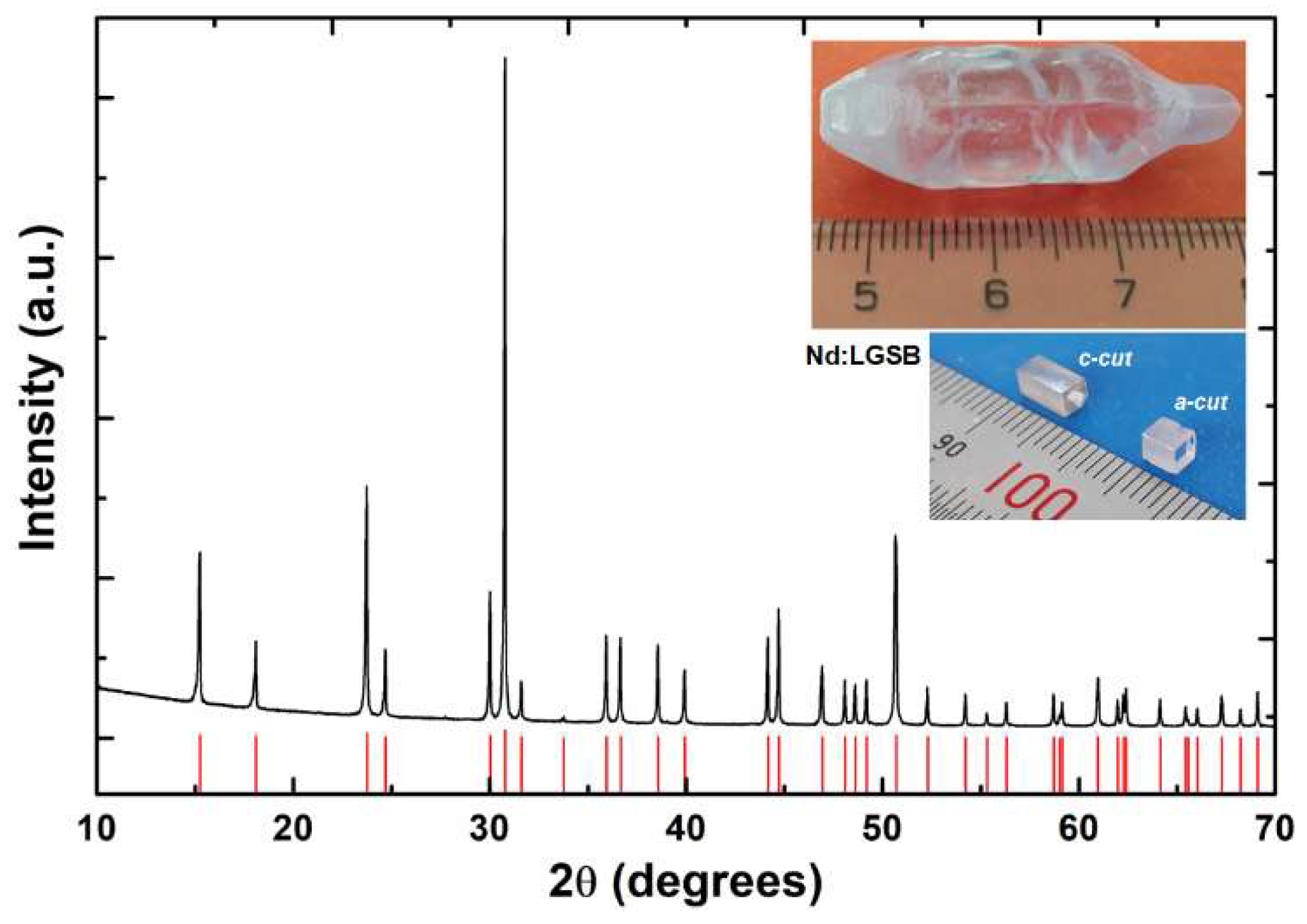
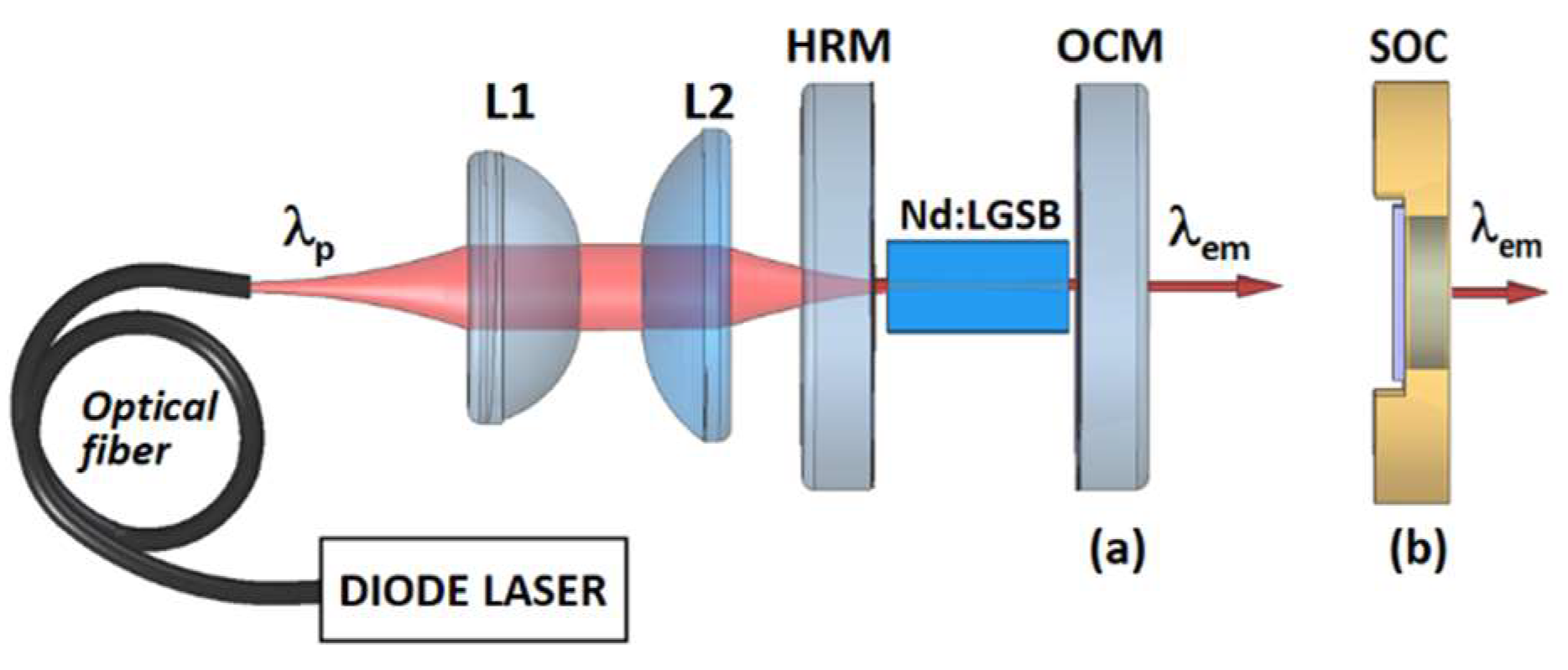

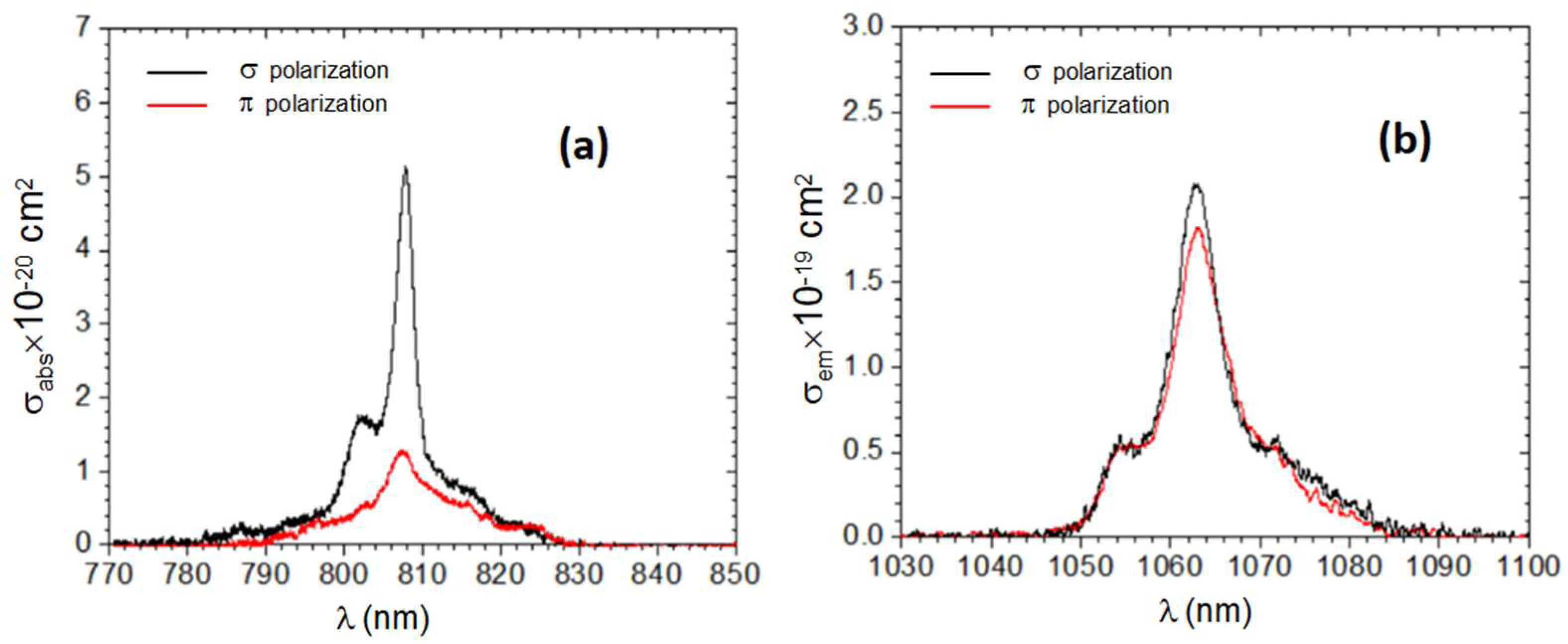
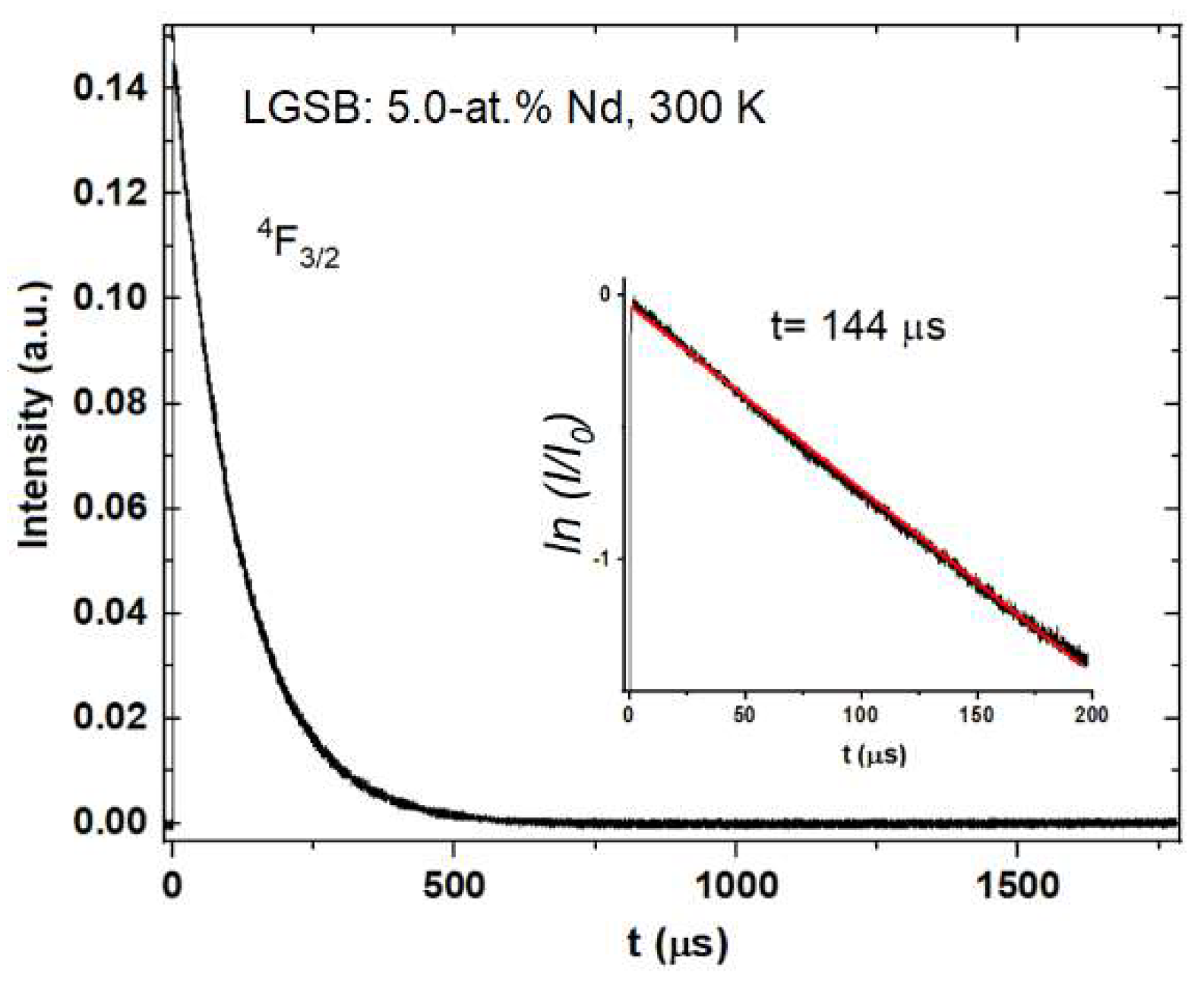
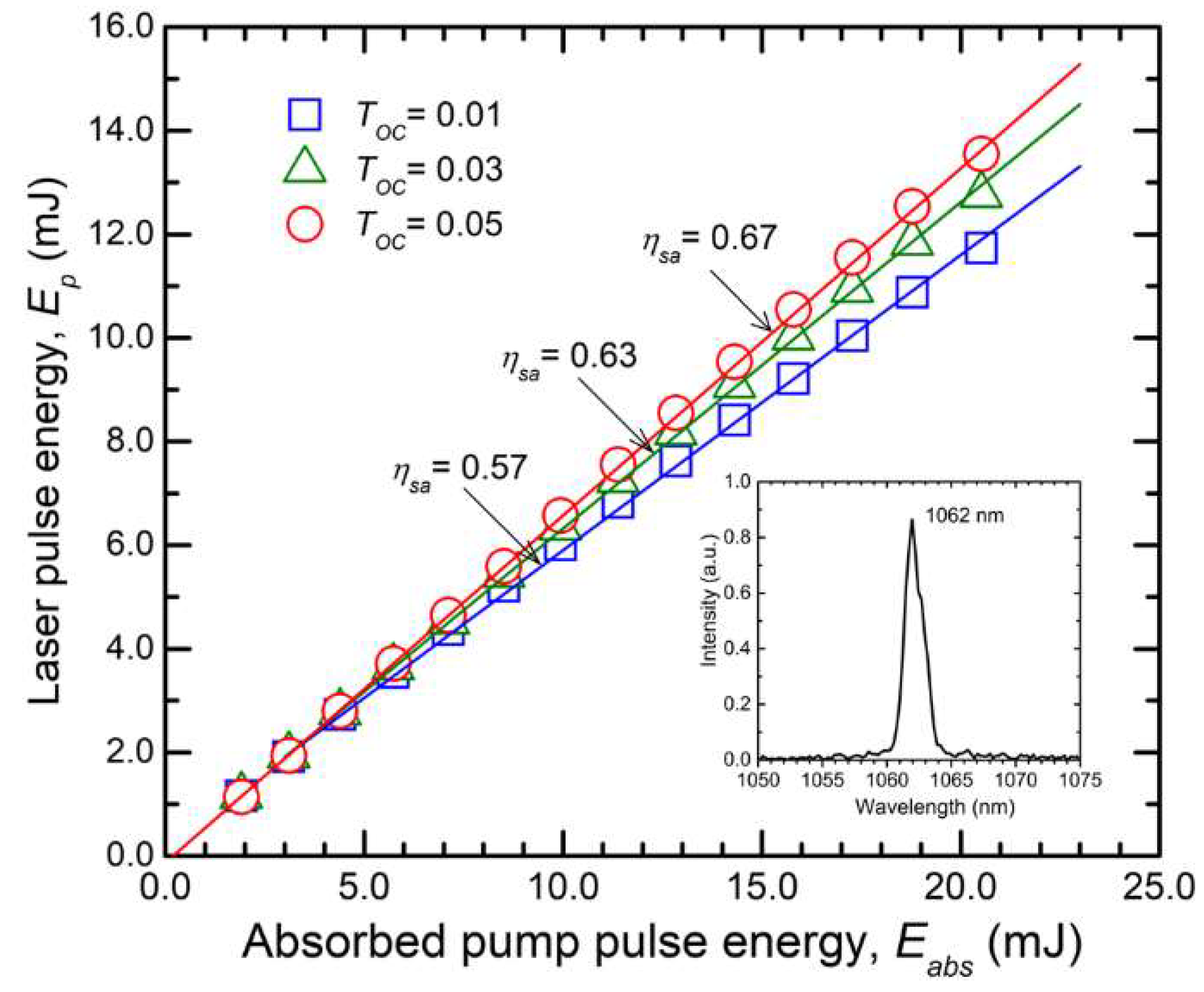
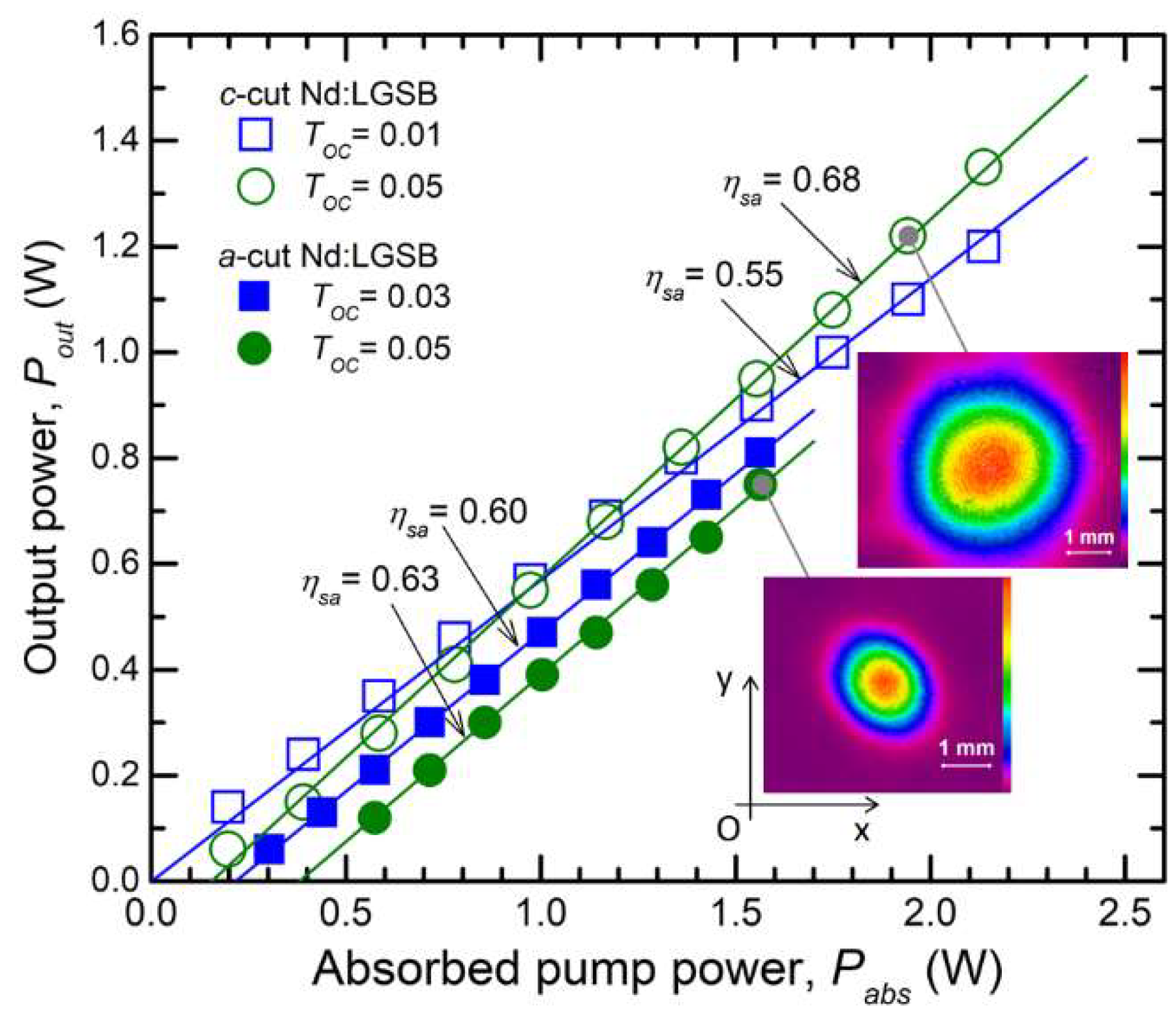
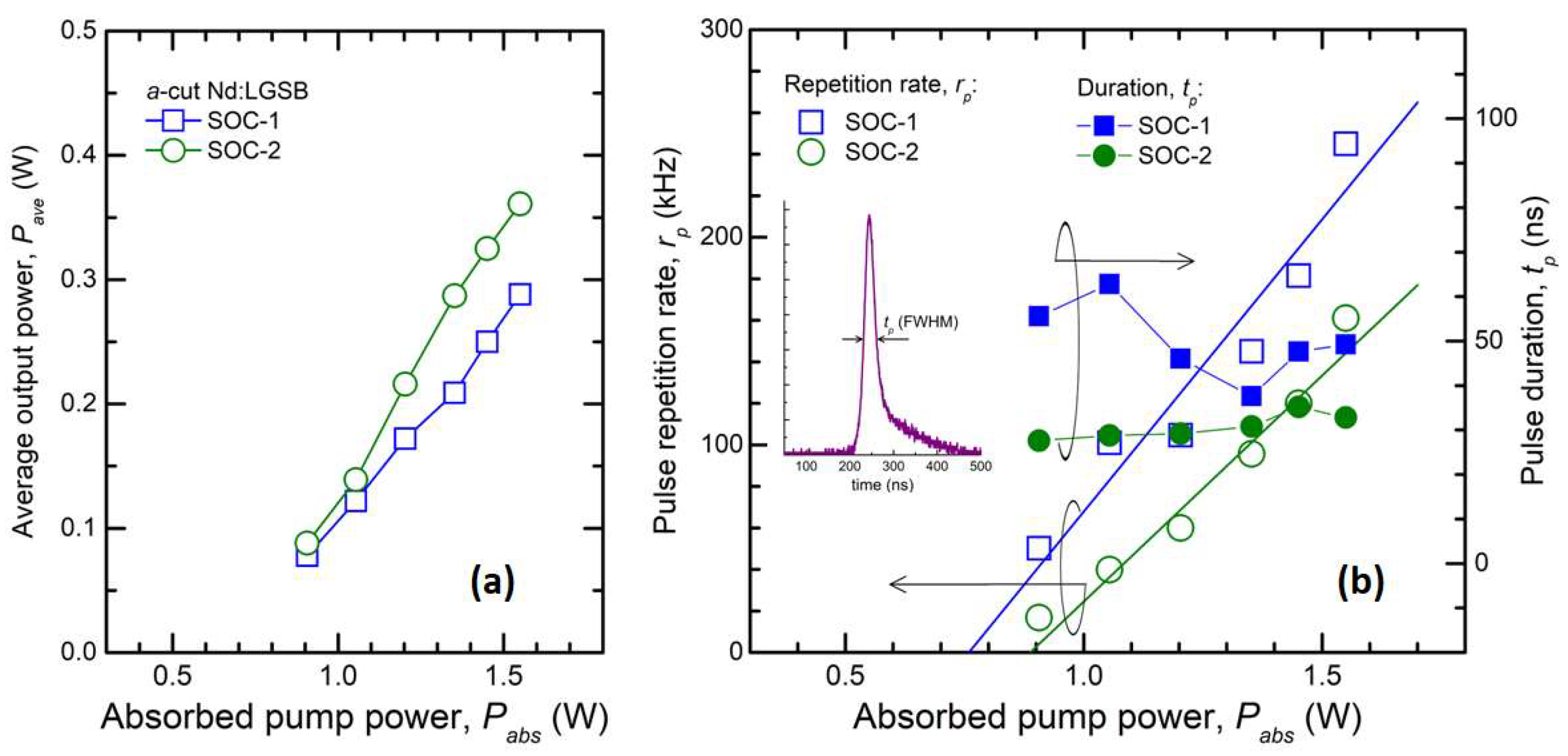
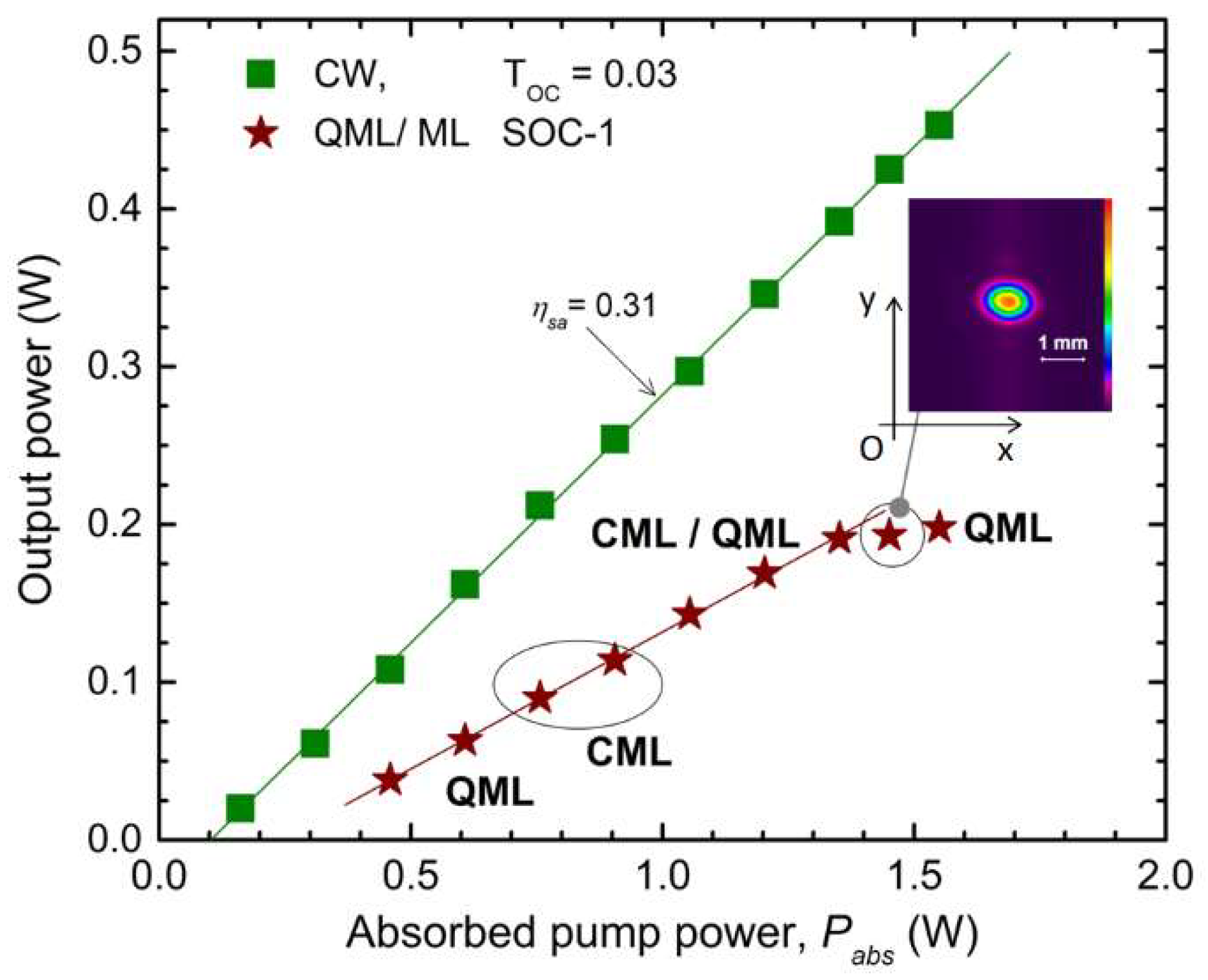
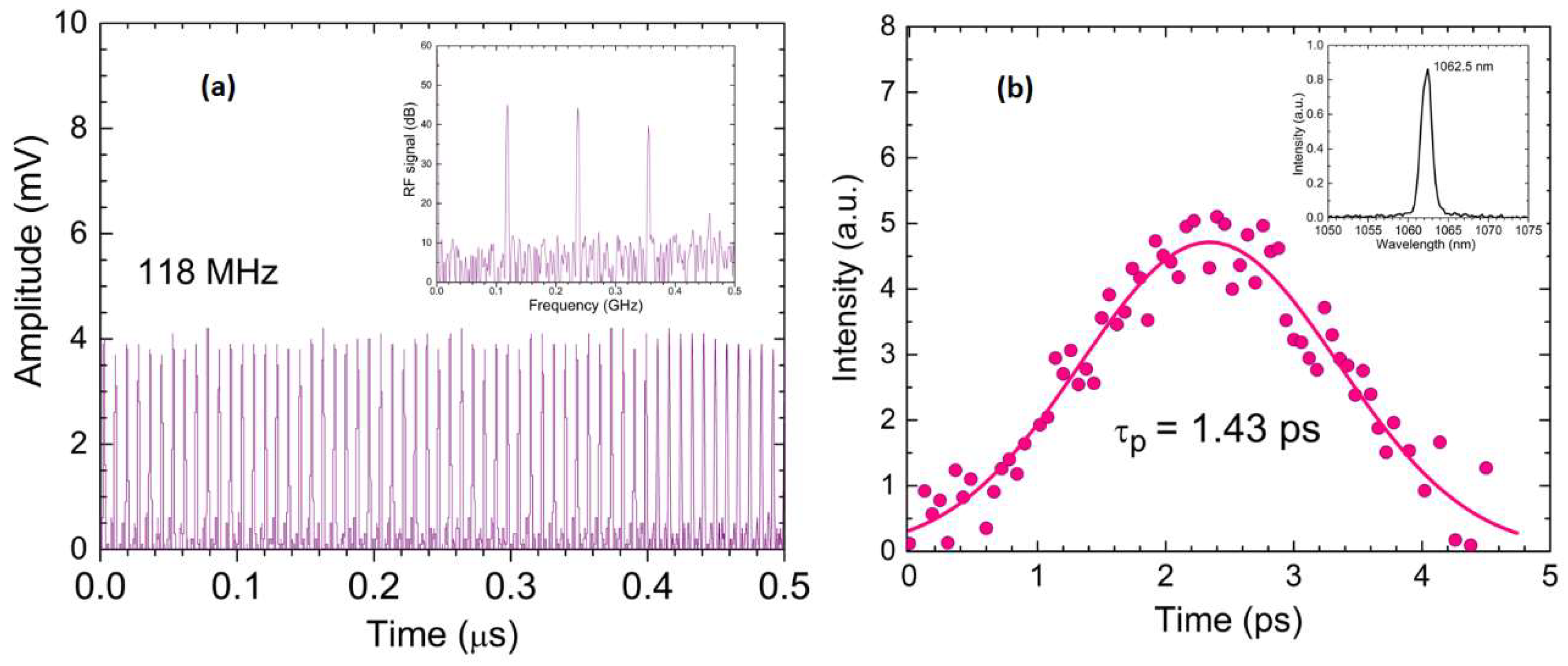
| Material | σabs (10−20 cm2) | τf (µs) | λem (nm) | Emission Bandwidth (nm) | σem (10−20 cm2) | Saturation Intensity (kW/cm2) |
|---|---|---|---|---|---|---|
| Nd:LGSB (this work) | 5.1 (π) 1.3 (σ) | 144 (5.0-at.% Nd) | 1063 | 6.5 (σ) 7.3 (π) | 2.1 (σ) 1.8 (π) | 6.18 |
| Nd:YAG [23] | 7 | 240 | 1064 | 0.5 | 3.3 | 2.36 |
| Nd:YVO4 [13] | 27 | 95 (1.0-at.% Nd) | 1064 | 0.8 | 19.5 | 1 |
| Nd:LSB [23,38] | 7.1 | 118 (10-at.% Nd) 150 (5.0-at.% Nd) | 1063 | 4 | 1.3 [23] 1.45 [38] | 12.2 [23] 8.6 [38] |
| Nd:GdCOB [39] | 2.3 | 98 (4.0-at.% Nd) | 1061 | 3.5 | 0.29 | 65 |
| Nd:YAB [40] | 2.3 | 60 (4.0-at.% Nd) | 1061 | 9 | 10 | 3.12 |
© 2019 by the authors. Licensee MDPI, Basel, Switzerland. This article is an open access article distributed under the terms and conditions of the Creative Commons Attribution (CC BY) license (http://creativecommons.org/licenses/by/4.0/).
Share and Cite
Brandus, C.-A.; Hau, S.; Broasca, A.; Greculeasa, M.; Voicu, F.-M.; Gheorghe, C.; Gheorghe, L.; Dascalu, T. Efficient 1 µm Laser Emission of Czochralski-Grown Nd:LGSB Single Crystal. Materials 2019, 12, 2005. https://doi.org/10.3390/ma12122005
Brandus C-A, Hau S, Broasca A, Greculeasa M, Voicu F-M, Gheorghe C, Gheorghe L, Dascalu T. Efficient 1 µm Laser Emission of Czochralski-Grown Nd:LGSB Single Crystal. Materials. 2019; 12(12):2005. https://doi.org/10.3390/ma12122005
Chicago/Turabian StyleBrandus, Catalina-Alice, Stefania Hau, Alin Broasca, Madalin Greculeasa, Flavius-Marian Voicu, Cristina Gheorghe, Lucian Gheorghe, and Traian Dascalu. 2019. "Efficient 1 µm Laser Emission of Czochralski-Grown Nd:LGSB Single Crystal" Materials 12, no. 12: 2005. https://doi.org/10.3390/ma12122005





